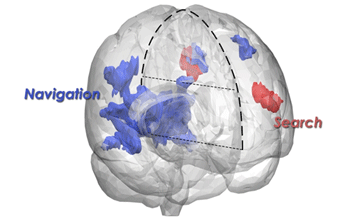Navigating our way through computer files uses the same brain structures as a dog finding its bone

More than 95 per cent of us waste time navigating through computer files rather than using efficient search tools because of the way our brains are structured, according to a new study.
Psychologists from the University of Sheffield used neuroimaging to find out why we often use lengthy access methods, such as scrawling through folders or use endlessly long pathways to documents that don't make immediate sense.
Researchers found that there are two main ways to retrieve personal files: hierarchical navigation and query-based search.
In navigation, users move down their virtual folder hierarchy until they reach the folder in which the target item is stored. When searching, users first generate a query specifying some property of the target file, and then select the relevant file from search results.
Dr Yael Benn, from the University of Sheffield's Department of Psychology, said: "Despite advances in search technology, research consistently shows that users prefer retrieving files using virtual folder navigation, rather than the more flexible query-based search.
"We wanted to investigate why people prefer navigation over search when accessing digital information. One suggestion by Dr Ofer Bergman from Bar-Ilan University, is that during folder navigation people use the same brain structures that have evolved over millions of years for navigating in the physical world.
"Working with Dr Bergman we discovered that generating search terms may be cognitively demanding of linguistic resources, particularly when those same resources are also needed for writing and editing documents."
The international, interdisciplinary team led by Dr Benn, including researchers from the University of Sheffield, University College London and the University of California, examined how the brain responded to computer search and file navigation tasks using functional Magnetic Resonance Imagining (fMRI).
The team extracted a list of recently used file names from their participants' laptops, and then asked them to navigate to some of these files and search for others, while recording their brain activity.
The results, published in Scientific Reports confirmed both theories. Folder navigation resulted in activation of the same brain areas as real-world navigation. These areas are in posterior areas of the brain and are active when humans make their way home from work, when racing pigeons find their way back or even when a dog buries a bone in the garden and knows instinctively where to find it again.
In contrast, searching for a file with key words activated a frontal brain region which is closely linked to linguistic processing called Broca's area. This is a function which is unique to humans.
Dr Benn added: "These results provide one explanation of users' preference for navigation over search when retrieving information items from their personal computers.
Humans have developed mechanisms over millions of years that allow them to retrieve an item from a specific location, be it real or virtual, by navigating the path they followed in storing the information.
"These deep-rooted neurocognitive biases lead to automatic activation of retrieval routines, which have minimal reliance on linguistic processing, leaving the language system available for other tasks."














